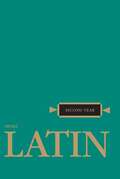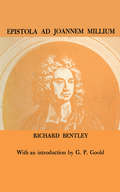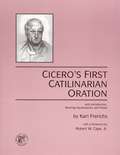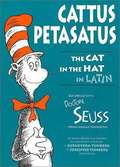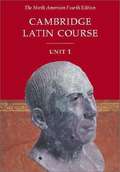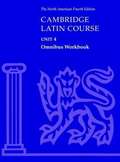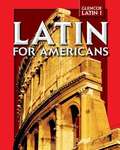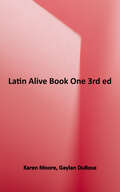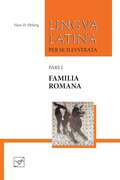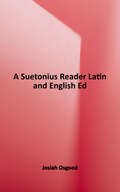- Table View
- List View
Second Year Latin
by Robert J. HenleThe backbone of Henle Latin Second Year is intensive language study, including review of the first year plus new materials. Separated into four parts, Henle Latin Second Year includes readings from Caesar's Commentaries, extensive exercises, and Latin-English vocabularies. Humanistic insight and linguistic training are the goals of the Henle Latin Series from Loyola Press, an integrated four-year Latin course. Time-tested and teacher endorsed, this comprehensive program is designed to lead the student systematcially through the fundamentals of the language itself and on to an appreciation of selected classic texts.
Winnie Ille Pu
by Alexander Lenard A. A. Milne"... diem cum Pu ac Porcellus heffalumpum capere conati sunt ..." "Non ceperunt, ceperuntne?" "Minime vero." Tu nequivit, quia omnis cerebri expers est. Ego autem heffalumpum cepi?" "Vere, istud pars fabulae est." Christophorus Robinus adnuit: "Egomet reminiscor," dixit. "Sed eae res fugiunt Pui memoriam, qua de causa fabulas bis narratas diligit. Tum tamen fabula vera est, non solum opus memoriae." "Equidem non secus sentio," dixi. Christophorus Robinus suspirium ab imo duxit, ursum pede apprehendit et Pum post se trahens ad ostium iit. Apud ostium se convertens dixit: "Venisne ut me in balneo videas?" "Possum," dixi. "Num eum ictu laesi?" "Minime vero." Adnuit et exiit et interposito deinde brevi tempore audivi Winnie ille Pum BUMP-BUMP-BUMP gradibus post eum ascendere.
Epistola ad Joannem Millium
by Richard Bentley G. P. GooldThe year 1962 marks the tercentenary of the birth of Richard Bentley (1662-1742), Master of Trinity College, Cambridge, editor of Paradise Lost, but principally and justly famous as one of the greatest classical scholars. To mark the event, the University of Toronto Press is issuing a special reprint of Alexander Dyce's edition of the Epistola (1691), the work which first brought Bentley fame, and which has long been out of print.<P><P>This Latin exercise was called forth by one of those unhappy productions which, mediocre themselves, have had the ill luck to attract the inspection of genius. In the eighth or ninth century A.D., Joannes Malelas of Antioch, a Greek writer, attempted a chronological record of mankind and in it he had recourse to name or quote from classical works no longer extant. English scholars in the seventeenth century prepared a translation of the chronicle into Latin and an accompanying commentary; just before its publication, under the final editorship of John Mill, Bentley was given an opportunity to read proof-sheets and the result was the Epistola, a collection mainly of some twenty-five notes upon statements found in or topics suggested by Malelas. <P>This extraordinary performance by a scholar of 29 moves from one topic to another over a wide range of ancient literature, explaining or correcting some sixty Greek and Latin authors. The notes are not so much a commentary on the old chronicler as a set of dazzling dissertations pegged upon a random set of appalling howlers, and they reveal prodigious information and gift of divination. Bentley's style in Latin is clear and spirited and seasoned with choice of quotation. <P>The Epistola immediately secured for its writer the fame reserved for men of the rarest excellence and this classic among academic productions is still charged with power to instruct and inspire the scholarship of another era.
Cicero's First Catilinarian Oration with Introduction, Running Vocabularies, and Notes
by Karl Frerichs Marcus Tullius Cicero Laurie Haight KeenanCicero's First Catilinarian speech is now available in a practical and inexpensive annotated edition for third-year Latin students. In light of existing textbooks, Karl Frerichs' edition has several important and distinguishing strengths: -- Clear, tripartite page layout for text, vocabulary and notes on facing pages-- Running vocabulary separate from notes and complete vocabulary at the end-- Introduction and Glossary of Terms and Figures of Speech provide basic biographical, historical, and rhetorical background-- Maps and illustrations
Cattus Petasatus: The Cat in the Hat in Latin
by Jennifer Morrish Tunberg Terence Tunberg SeussIncludes a Latin-English glossary and a note on the verse form and rhythm.
Cambridge Latin Course, Unit 1
by Stephanie M. Pope Patricia E. Bell Stan Farrow Anne Shaw Randy Thompson Joy Mellor Leslie Jones Peter Kesteven Neil SuttonThe Fourth Edition Cambridge Latin Course is an introductory program organized into four well-integrated units. Cambridge's proven approach includes a stimulating continuous story line, interwoven grammatical development and cultural information, supportive illustrations and photographs, and a complete Language Information section. Reading is the heart of the Cambridge Latin Course, and all the elements of the program - illustrations, vocabulary, grammar and syntax, cultural contexts and references, activities - are carefully introduced and arranged to provide students with the skills they need to read with comprehension and enjoyment from the very first page.
Cambridge Latin Course, Unit 4, Omnibus Workbook
by Stephanie M. Pope Patricia E. Bell Stan Farrow Richard M. Popeck Anne Shaw Joy Mellor Leslie Jones Peter Kesteven Neil SuttonThe North American Cambridge Latin Course is a well-established four-part Latin program whose approach combines a stimulating, continuous storyline with grammatical development, work on derivatives, and cultural information. There is also a complete Language Information section, plus numerous color photographs illustrating life in the Roman world. The Course has now been fully revised and updated in light of feedback from user schools, and includes the very best in new research. The Fourth Edition continues to offer teachers and students alike a stimulating, reading-based approach to the study of Latin. The Omnibus Workbook is designed to be used in conjunction with the Unit 4 Student's Text. A variety of exercises is provided for each Stage.
Latin Alive! (Latin Alive Series #Book One)
by Karen Moore Gaylan DuBoseStudents will be delighted by what they learn in each new chapter of Latin Alive!, Book One, and they will learn to see that Latin is everywhere around them. As the first text in a three-year series, it is a rigorous and thorough introduction to this great language and is designed to engage upper school (middle and high school) student. Brimming with relevant facts and stories this text offers something for everyone. A Teacher’s Edition including answer keys, teacher’s helps and additional activities is available separately.
Familia Romana (Lingua Latina #Book One)
by Hans H. ØrbergHans Ørberg's Lingua Latina per se Illustrata is the world's premiere series for learning Latin via the Natural Method. The Natural Method encourages students to learn Latin without resorting to translation, but instead by teaching them to think in the language: students first learn grammar and vocabulary inductively through extended contextual reading and an ingenious system of marginal notes. Lingua Latina per se Illustrata is also the most popular series for those teachers at both the secondary and collegiate levels who wish to develop Latin conversational skills in the classroom. <p><p>Familia Romana (the main book of Pars I of the Lingua Latina per se illustrata series) contains thirty-five chapters and describes the life of a Roman family in the 2nd century A.D. It culminates in readings from classical poets and Donatus's Ars Grammatica, the standard Latin school text for a millennium. Each chapter is divided into two or three lessons (lectiones) of a few pages each followed by a grammar section (Grammatica Latina) and three exercises (Pensa). Hans Ørberg's impeccable Latin, humorous stories, and the Peer Lauritzen illustrations, reproduced in full color, make this work a classic. The book also includes a table of declensions, a Roman calendar, and a word index (index vocabulorum). <p><p>The Lingua Latina series incorporates the following features: <p><p>The most comprehensive treatment of Latin grammar available in an elementary textbook. <p><p>A vocabulary of almost 1,800 words, reinforced by constant and creatively phrased repetition, vastly expands the potential for later sight reading. <p><p>A complete line of ancillary volumes, exercises, and readers both in print and online.
A Suetonius Reader: Selections From the Lives of the Caesars and the Life of Horace
by Josiah OsgoodThe popular appeal of Suetonius' Lives of the Caesars is obvious. Who would not thrill reading about the great Julius Caesar's delight in the Senates bestowal of the right to wear a laurel wreath on all occasions because it covered his baldness? Or that the Divine Augustus had rotten teeth and wore special platform shoes to make himself look taller? <p><p>Suetonius, however, has not always been as enthusiastically received among historians, who sometimes overlook that he intended his work as biography, not history, or that he patently aimed for prose that was not literary, but instead unadorned, clear, and concise. Such qualities of prose, however, happily make his Latin enjoyable both to teach and to read. And while Suetonius' details of the weird worlds of extraordinary men are endlessly entertaining, they are not merely that. This business like biographer produced an extraordinarily influential work. His Caesars is a landmark in the history of biographical writing, and remains a key source for the history of Rome, its transition from Republic to Empire, and contemporary efforts to come to terms with individual destiny, through astrology, physiognomy, dream analysis, and more. Through to the present day Suetonius has profoundly shaped modern perceptions of Roman society.
Caesar: Selections From His Commentarii De Bello Gallico
by Hans-Friedrich Mueller Julius Caesar Donald E. Sprague Bridget S. DeanNIMAC-sourced textbook
Vergil's Aeneid: Selected Readings From Books 1, 2, 4, And 6
by Barbara Weiden Boyd Vergil Bridget Buchholz D. Scott Van HornNIMAC-sourced textbook
Ovid: Amores, Metamorphoses Selection
by Charbra Adams Jestin Phyllis B. Katz Ovid Bridget Dean Laurie Haight Keenan Laurel DraperNIMAC-sourced textbook
A Song of War: Readings from Vergil's Aeneid
by Richard A. Lafleur Alexander G. MckayNIMAC-sourced textbook
Cicero: Pro Archia Poeta Oratio (Annotated Latin Collection)
by Steven M. Cerutti Cicero Gaby HuebnerNIMAC-sourced textbook
